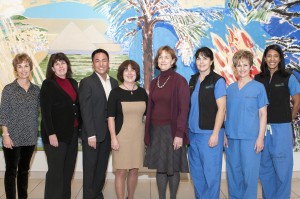Let there be light

The VGH team responsible for the photodisinfection trial. From left to right: Shelagh Weatherill, Nurse Consultant, Shelley Errico, Patient Service Manager, VGH Perioperative Care Unit; Dr. Titus Wong, Medical Microbiologist; Dr. Elizabeth Bryce, Regional Medical Director, Infection Control; Dr. Diane Roscoe, Regional Division Head, Microbiology; Kelly Barr, Patient Care Co-ordinator; Dawn Breedveld, Clinical Educator; Lori, Haas, LPN.
When VGH Licensed Practical Nurse Lori Haas participated in an innovative treatment trial for a pre-surgical disinfecting light treatment, she had no idea that she’d be playing a key role in improving patient safety.
“Prior to this experience, I knew nothing about photodisinfection,” said Lori, one of the nurses responsible for administering the novel new treatment that involves shining a beam of light into the nostrils of patients just prior to their surgeries to kill the harmful bacteria that can colonize in a person’s nasal passages.
“I learned a whole lot thanks to this new technology,” she added. “Taking part in this trial made me more aware of how germs are spread, and this knowledge allowed me to give better care to my patients. Most patients were not aware that the bacteria already living on their bodies can cause a surgical site infection after their surgery.”
The treatment trial at VGH combined the use of photodisinfection with chlorhexidine body wipes prior to surgery to decrease a patient’s bacterial load — on their skin and in their nostrils — to lessen the risk of post-operative surgical site infections.
The treatment trial, the first of its kind, reduced the incidence of surgical site infections by an impressive 39 per cent. A multidisciplinary team including Medical Microbiology, Infection Control, Surgery, Perioperative Services and Patient Safety worked together to make the treatment trial a success.
“It was the dedication of this multidisciplinary team that made the pilot so successful,” said Dr. Elizabeth Bryce, Regional Medical Director, Infection Control. “This technology’s important because we found a safe treatment that decreases the risk of surgical site infection and does this without antibiotic resistance.”
This new two-step procedure not only reduced the occurrence of surgical site infections – which cost VGH approximately $1.9 million annually to treat — but also takes just 10 minutes to administer pre-surgery, and it is absolutely painless for the patient.
But it is the increase to patient safety that resonated with VGH frontline staff who participated in this photodisinfection project.
“Initially, specimen results would show when patients were colonized with either MRSA or Staphylococcus aureus. And immediately after treatment, the bacteria were gone,” Lori said. “Taking part in this project really made me feel like I was making a difference in the health of patients going in for surgery.”
To learn more about the photodisinfection project at VGH, read the full news release or watch the story on Global BC News at 6.

